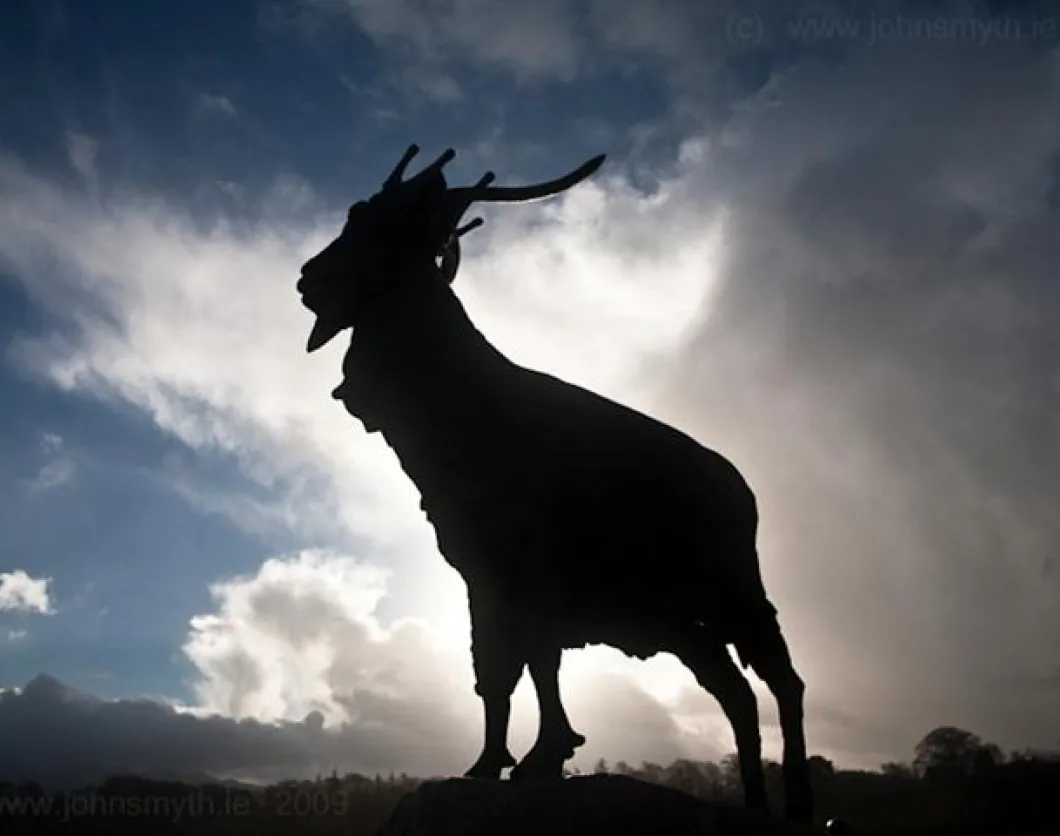While at one time it was notorious for drinking, with the pubs open round-the-clock for three days and nights, nowadays, Puck Fair is famous for meeting up with old friends, forging new friendships and putting the cares of everyday living on hold. But how did it all get started? Nobody knows the exact origins, but it is said to date to medieval times – or perhaps even before then.
King Puck
The most widely mentioned story relating to the origin of King Puck, associates him with the English Ironside Leader Oliver Cromwell. It is said that while the Roundheads were pillaging the countryside at the foot of the McGillycuddy Reeks, they routed a herd of goats grazing on the upland. The animals took flight before the raiders, and the he-goat or "Puck" broke away on his own and lost contact with the herd. While the others headed for the mountains he went towards Cill Orglain (Killorglin) on the banks of the Laune. His arrival there in a state of semi exhaustion alerted the inhabitants of the approaching danger and they immediately set about protecting themselves and their stock. It is said that in recognition of the service rendered by the goat, the people decided to institute a special festival in his honour and this festival has been held ever since.
Other legends regarding the origin of King Puck relates to the time of Daniel O'Connell, who in 1808 was an unknown barrister. It seems that before that year, the August fair held in Killorglin had been a toll fair, but an Act of the British Parliament empowered the Viceroy or Lord Lieutenant in Dublin to make an order, at his own discretion, making it unlawful to levy tolls at cattle, horse or sheep fairs. Tolls in Killorglin at this time were collected by the local landlord – Mr. Harman Blennerhassett – who had fallen into bad graces with the authorities in Dublin Castle and as a result the Viceroy robbed him of his right to levy tolls. Blennerhassett enlisted the services of the young Daniel O'Connell, who in an effort to reverse the decision decided that goats were not covered by the document and that the landlord would be legally entitled to hold a goat fair, and levy his tolls as usual. Thus the fair was promptly advertised as taking place on August 10th, 1808, and on that day a goat was hoisted on a stage to show to all attending that the fair was indeed a goat fair – thus Blennerhassett collected his toll money and Killorglin gained a King.
{%C3,4%}
The Fair Itself
There are many wild inventive tales about how it began, but there is no definitive written record. However, we do know that in 1603 a charter by King James I granted legal status to a fair in Killorglin. Whether or not it’s the Puck Fair of today, we don’t know for certain and various commissions set up over the past two hundred years have tried in vain to find out. Evidence suggests that the fair existed long before written record of everyday occurrences were kept as there is one written reference from the 17th Century in existence which grants Jenkins Conway, the local landlord at the time, the right to collect a sum for every animal brought to the August Fair. This would suggest that a fair at this time of year was something already well established in the local community.
It has also been suggested that it is linked to pre-Christian celebrations of a fruitful harvest and that the male goat or "Puck" was a pagan symbol of fertility, similar to the pagan god Pan. Whatever its origins, the fair has long been and continues to be the main social, economic and cultural event in the Killorglin Calendar.
It is attended by upwards of 100,000 people according to the organisers, and, while copious amounts of alcohol are still consumed there’s a much bigger emphasis now on musical entertainment and fun on the streets.
The highlights of 2010 included pipe bands, trad sessions, Wobbly Circus Walkabouts, Music, Dance & Storytellinga by Sproai Ciarrai, The Blues Bells, The Walls, craft fair, and headlining the final concert of the festival is the world famous traditional group De Dannan. Their performance was followed by a massive fireworks display to bring the curtain down for another year.
By Bridget Haggerty
www.irishcultureandcustoms.com
www.puckfair.ie









